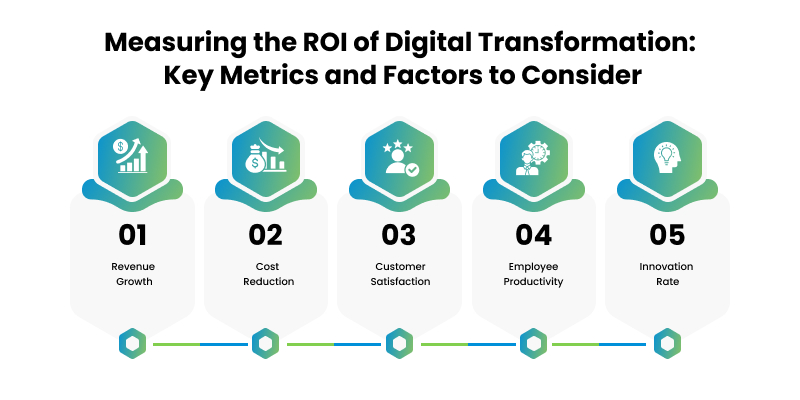Measuring ROI in Digital Transformation: A Comprehensive Guide

Digital transformation is a strategic imperative for businesses aiming to remain competitive in today’s tech-driven environment. While its benefits are vast—ranging from enhanced operational efficiency to superior customer experiences—quantifying the return on investment (ROI) is often a complex challenge.
In this article, we’ll explore the importance of measuring ROI in digital transformation, methodologies for calculation, and strategies to ensure maximum returns.
Why Measuring ROI Matters in Digital Transformation
Every digital transformation initiative requires significant investments in technology, training, and processes. Without clear ROI metrics, organizations risk:
- Misaligned goals.
- Overspending on underperforming tools.
- Failing to achieve desired outcomes.
Key benefits of measuring ROI include:
- Justifying Investments: Clear ROI metrics help stakeholders understand the value of transformation initiatives.
- Driving Continuous Improvement: Measuring results identifies gaps and areas for optimization.
- Aligning Objectives: Establishing measurable outcomes ensures alignment with business goals.
“What gets measured gets managed.” Accurate ROI assessment is essential for informed decision-making and long-term success.
Steps to Measure ROI in Digital Transformation
1. Define Clear Objectives
Before starting, outline the specific goals of your digital transformation efforts. Examples include:
- Reducing operational costs by automating workflows.
- Increasing revenue through improved customer experiences.
- Enhancing employee productivity with collaboration tools.
2. Identify Key Metrics
Choose measurable metrics that align with your objectives:
- Operational Efficiency: Time saved, process improvements.
- Revenue Growth: Increased sales, higher customer retention rates.
- Customer Satisfaction: Net Promoter Score (NPS), reduced response times.

3. Calculate Total Costs
To measure ROI, you must account for all costs, including:
- Technology investments (software, hardware).
- Training and upskilling employees.
- Implementation and ongoing maintenance.
4. Measure Gains
Evaluate tangible and intangible benefits:
- Tangible: Increased revenue, cost savings.
- Intangible: Improved brand reputation, employee satisfaction.
ROI Formula:
ROI = (Net Benefits – Total Costs) / Total Costs x 100%
5. Use Analytics Tools
Leverage advanced analytics tools to gather and interpret data. Platforms like Google Analytics, Tableau, and Power BI provide actionable insights.
Common Challenges in Measuring ROI
1. Long-Term Nature of Digital Transformation
Many benefits, such as enhanced customer loyalty, materialize over time, complicating ROI measurement.
2. Intangible Benefits
How do you quantify improved employee morale or enhanced brand perception?
3. Lack of Standardized Metrics
Different industries and organizations may require unique metrics, making comparisons difficult.

Strategies for Optimizing ROI
1. Align Transformation with Business Goals
Ensure every digital initiative is closely tied to core business objectives.
2. Pilot Projects
Start small by running pilot projects to test the feasibility and potential ROI of larger initiatives.
3. Employee Training
A well-trained workforce maximizes the potential of new technologies, driving greater returns.
4. Partner with Experts
Collaborate with digital transformation consultants to gain expert guidance and avoid common pitfalls.
Explore More: Benefits of digital transformation consulting.
Real-World Examples of Measuring ROI
Case Study 1: Retail Industry
A leading retailer implemented AI-driven inventory management, reducing overstock by 20% and cutting operational costs by $1.5 million annually.
Case Study 2: Healthcare
A hospital adopted telemedicine solutions, enabling a 30% increase in patient consultations and a 40% reduction in overhead costs.

Key Metrics to Track ROI in Digital Transformation
- Customer Metrics:
- Customer retention rate.
- Average revenue per user (ARPU).
- Operational Metrics:
- Process efficiency improvements.
- Reduction in manual errors.
- Financial Metrics:
- Cost savings from automation.
- Increased profit margins.
- Employee Metrics:
- Productivity rates.
- Employee engagement and satisfaction scores.
FAQs on Measuring ROI in Digital Transformation
Q1: Why is ROI measurement difficult in digital transformation?
A: The challenge arises from intangible benefits, varying timelines, and the complexity of transformation initiatives.
Q2: Can ROI be negative initially?
A: Yes, initial costs may outweigh benefits during the early stages. Long-term ROI often turns positive as initiatives mature.
Q3: How often should ROI be measured?
A: Regularly—preferably quarterly or biannually—to track progress and make necessary adjustments.
Q4: What tools can help measure ROI?
A: Analytics tools like Salesforce, HubSpot, and Google Analytics are invaluable for tracking metrics and visualizing ROI.
Conclusion
Measuring ROI in digital transformation is crucial for ensuring the success and sustainability of your initiatives. By defining clear objectives, selecting the right metrics, and leveraging advanced tools, businesses can confidently navigate their transformation journey.
In the ever-evolving digital landscape, accurate ROI measurement isn’t just about justifying costs—it’s about unlocking opportunities for innovation and growth.
Don’t wait to measure your success—embrace the metrics that matter, and transform your business with confidence!

